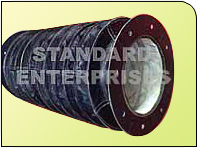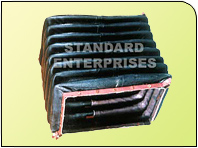We have one of the largest selections of Moulded Leather Bellows in the world. We can currently offer 50.000 different types and styles. All bellows are made of a special composition of PVC-materials. These bellows can be used within a normal temperature range of -20 o ; C//22 o ;F and +80 o C/200 o F. They offer an excellent seal and protection against dust. We also manufacture soft pvc bellows according to your specifications. Die costs are moderate.
Leather Molded Bellows
Leather molded bellows refer to a specific type of flexible, expandable device primarily made from leather. These bellows are designed to expel air when compressed and draw in air when expanded, facilitating airflow in a controlled manner. The "molded" term usually implies that the leather has been shaped or formed into specific contours or folds to allow for this expandable action.
Leather-molded bellows are devices designed to deliver a blast of air. The most traditional use of bellows is in blacksmithing to intensify the heat of a fire. However, leather bellows can also be found in various other applications, such as musical instruments or for circulating air in a fireplace.
We have one of the largest selections of Moulded Leather Bellows in the world. We can currently offer 50.000 different types and styles. All bellows are made of a special composition of PVC-materials. These bellows can be used within a normal temperature range of -20 o ; C/22 o ;F and +80 o C/200 o F. They offer an excellent seal and protection against dust. We also manufacture soft pvc bellows according to your specifications. Die costs are moderate.
Components & Making of Leather Moulded Bellows :- Components :
- Leather : Traditionally, flexible, durable leather is used. It provides a good balance between flexibility and resistance to wear. Over time, leather can dry out and become brittle, so it's important to maintain and condition it.
- Valves: There's usually at least one valve to allow air to be sucked in when the bellows are expanded, but not let it out when the bellows are compressed.
- Boards: Hardwood boards are typically placed at the top and bottom to provide structure and to allow the user to operate the bellows.
- Components :
- Cutting the Leather: Begin by cutting out the leather into the desired shape. This can vary based on the specific design and size of the bellows.
- Sewing: The edges of the leather are typically sewn together to form the body of the bellows. Depending on the design, it may require a single seam or multiple seams.
- Adding the Boards: Attach the hardwood boards to the top and bottom of the leather. This can be done using nails, screws, or other methods. Make sure the edges of the boards align well with the edges of the leather for an airtight seal.
- Valve Construction: Incorporate one or more valves into the design, ensuring they allow air in but prevent it from escaping in the reverse direction.
- Finishing: Condition the leather to keep it flexible and durable. You may also choose to add decorative elements or handles to the bellows.
Leather can degrade over time, especially if exposed to high heat or moisture. To ensure longevity:
- Condition the Leather : Use leather conditioner regularly to keep the material supple.
- Store Properly : When not in use, store the bellows in a dry place away from direct sunlight or excessive moisture.
- Check for Leaks : Over time, the seams or the leather itself may develop small holes or tears. It's essential to inspect the bellows periodically and repair any damage promptly.
In conclusion, leather-moulded bellows are a traditional tool that has been used for centuries across various applications. Their construction is relatively simple, but like all tools, they require proper care and maintenance to ensure longevity.
Common applications industries for Leather Molded Bellows:- Blacksmithing and Metalworking: Historically, bellows were used to intensify the heat in forges and furnaces by introducing more oxygen, thereby making the burning fuel hotter. By pumping the bellows, a steady stream of air was provided to the coals, allowing the metal to reach the necessary temperatures for forging.
- Photography: Bellows, particularly in older cameras, were used to maintain flexibility between the camera body and the lens. This allowed photographers to adjust focus and to manipulate the plane of focus for special effects or corrections.
- Musical Instruments: Some musical instruments, like accordions or certain types of organs, utilize bellows to manage the flow of air over the reeds or pipes, producing sound.
- Machinery and Industrial Equipment: Bellows can serve as protective covers for machinery parts, keeping out contaminants while allowing for movement. They might cover joints, pistons, or other moving parts.
Leather is a traditional material for bellows because of its natural flexibility, durability, and the ability to create an airtight seal. When constructing leather bellows, the leather is often treated and molded into the desired shape, providing both flexibility and strength.
However, with advances in materials science, many modern bellows are made from synthetic materials like rubber or various types of plastics. These materials can often offer greater durability and resistance to environmental conditions than leather. Nonetheless, leather remains a choice material for certain applications, especially in contexts where traditional craftsmanship is valued.




